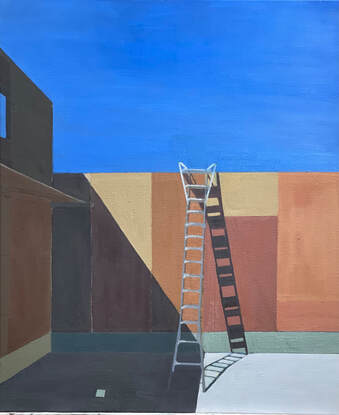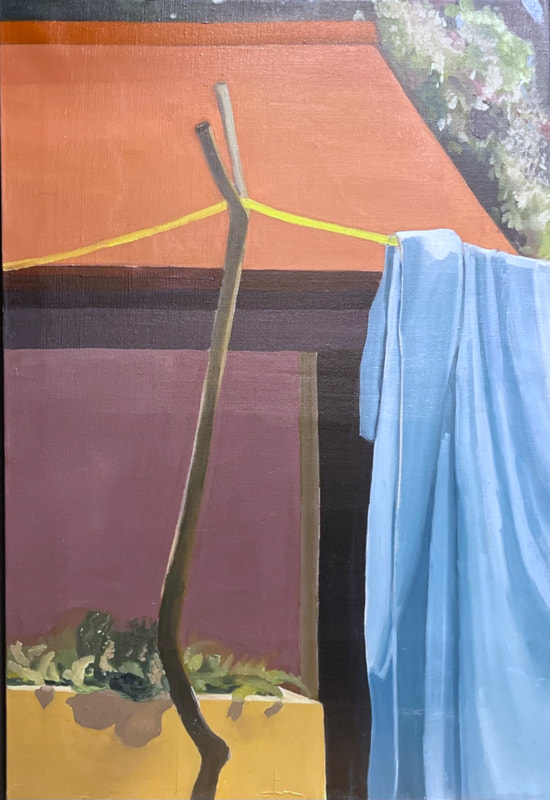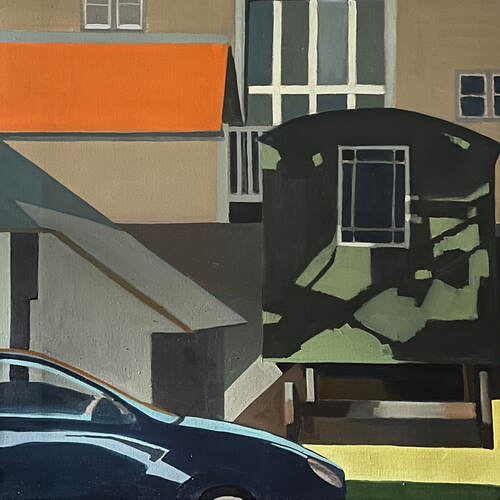|
This is one of the questions that I am exploring during the artist talk for the private view of 'Landscapes of Identity' on Wednesday 5th June 2024, at Gun Brewery, Gun Hill, Heathfield 17:30 onwards, with the talk at 19:00.
What are my primary sources of inspiration when making work? To start to unpick this question, I looked back over my work. My aunt, Lita Albuquerque, who is an international renown artist of many years advised me to document my work and thankfully I listened to her. When I started I thought it was a waste of time, mainly because it is not half as much fun as the creativity itself, but I diligently did it and now I am sp grateful. It allows me to contemplate the direction I've been heading in and to assess the implications of current, as well as future work. It is also a great way to stay in touch with what the art-making ultimately means to me. It is not for public publication, only for my individual use. When I look at these documents, I am instantly struck by the difference in my work that was before and after I changed from being only a landscape artist, to not giving myself this as a set boundary. At the same time I also started learning more about colour, colour mixing and I stuck to the practice of using a limited paint palette. This limited palette is:. French Ultramarine Blue - warm blue Phthalo Blue - cool blue Permanent Alizarin Crimson - cool red Cadmium Red - warm red Lemon yellow - cool yellow Cadmium yellow deep - warm yellow I can proudly say, that I can make most colours with a mix of any of above, including titanium white and Phthalo green. Inspiration can come from anywhere, different art forms, visiting galleries or museums, reading books or articles about artists, engaging with other artist. At the same time, remembering to expose myself to new ideas because other peoples' creative work can spark motivation, importantly to me is the peer reviews I have with other artists. Mainly, I find myself coming back to a very close circle that is my inspiration, it is my family, my experiences and myself. But I can only do this if I slow down, reflect and trust. Slow down - I do not see or hear the inspiration if I am busy or fast Reflect - I need to constantly pause between responses and actions Trust - if I don't trust, I don't find the reason to paint
It is a good feeling being seen as an artist and being chosen for exhibitions is one of the ways to be seen. Next part of this journey is to meet with my framer and have a creative discussion on how to complete this painting. Once framed it will go to London, probably under my arm and Ill drop it off at the gallery.
How Does It Feel to Get Shortlisted For the Royal AcademyThe Royal Academy in a building built in 1772 in Piccadilly London. A place that has been nurturing art students for over 250 years. Annually they run an open art competition, called the Summer Exhibition. The brand Hole and Corner writes an article about this very subject and see Being accepted into the Royal Academy’s annual Summer Exhibition is seen by many artists as an indication that you have ‘made it’ in the art world. Each year a Royal Academician member co-ordinatesthe exhibition, this year David Remfry RA; and he has chosen to explore the theme Only Connect, taken from the famous quote in Howards End by E.M. Forster. This year the exhibition will run from 13th June to 20th August 2023 The application process is highly organised. If you get through the digital submission stage (attracting about 20,000 submissions) there is a long short-list (1,500) of works that they want to see in the flesh. During the early part of May, Piccadilly is filled with artists with work under their arm and Burlington Gardens with vans with art onboard. I was sitting in my studio when I received the e-mail saying that I had been shortlisted. I was very excited, pleased and proud. What is the painting about?
Victoria is currently exploring themes of identity: what it is to be a woman, a mother, a sister, a daughter, a homeowner, a home-maker. What do these titles mean and how do they manifest themselves in our lives? Through an earlier training in psychology and psychotherapy Victoria explores what it means to have a sense of self, and how it manifests itself in the world we create around us. These observations touch not only on issues of self-understanding but also heritage and history, and the incomplete and subtle ways in which knowledge is handed down from one generation to the next. In Victoria’s work this sometimes appears (or disappears), leading to questions about whether the image is representing something from current reality: observation – or from personal or hand-me-down (collective) memory: imagination. Victoria’s paintings of the last 18 months depict fragments of familiar domestic environments often devoid of people to make physical the momentary sensation of the familiar which is often overlooked and to make it considered, noticed, and thought about. January Moment I had forgotten that the month of January is so cold with a rawness that goes into your bones; it’s post-Christmas which means that there is little in the way of gatherings to look forward to and this leads me to thinking about hibernation. But one thing that keeps me going is noticing that the sun rises earlier and sets later each day. In last month's newsletter I wrote about a book called Ways of Seeing by John Berger, which I came across in a bookshop in Bath. The book was published after a series on the subject, created by Berger, had been show on BBC television in the 1970s. The film quality, production style, fashion and hairstyles of the period are quite amusing to see – it’s interesting to see how much things have changed. The program starts by the presenter John Berger ripping/distroying the canvas of a classical painting - just take a time to see the start. The first episode (just google John Berger Seeing Ways on You Tube), which I found fascinating, looks at the role of painting in its original form and the power of such a form. Berger explains this power by showing a film extract of a pilgrim, hundreds of people paying their respect to their patron saint, by visiting a statue of the saint. Before copies, the religious followers would only be able to pay their respect too their saint by actually visiting the statue. Once we were able to copy an original form (take photograph and mass reproduce it) the followers could now worship their saint by visiting the image of their saint in their own home, even on the go from a photo in their own wallet. Berger goes on to explain that once an original image was copied, the copied image could be misinterpreted or ‘manipulated’ just by putting another image next to it; or in the case of film, adding sound. He talks about how we see reproduced images everywhere (and this was before the digital age) in magazines, postcards, posters and in our homes. He explains how the different context in which we view an image can give it a different meaning to the original one intended. As an artist in todays world, it is not possible to exist as an artist with out making copies of work. I have postcards and greeting cards of my work, for a while, I offered small mounted prints of landscapes and of course I use copies of my paintings in this article and on instagram. I often think through the prose and cons of selling original art and prints of art. I like the rawness/power of the original painting. To keep this value, I crop the image for the original painting to define that it is a reproduced image. Of course most of the time, you are totally unaware of this subtle difference. In the art world, it is said that a good reproduction comes from a not so good painting and a really good painting makes a bad reproduction. Another technique that I sometimes use to see whether a painting is good or not. There is nothing more powerful than an original painting and I want to remind you to take the time to visit galleries and take even meditative time to experience of being in a gallery, really looking at a painting, undistracted by the noised of the external world. |
AuthorI am a professional painting artist, with a passion for space, shadow, colour and balance - constantly pushing forward to express more of what I see and feel visually. Archives
June 2024
Categories
All
|
V i c t o r i a A l b u q u e r q u e A r t
|
W h a t o t h e r s s a y
|
|
Contact me via my mobile on 07900 117525
via e-mail on [email protected] studio address West Street Farm Studios Gun Hill Heathfield TN21 0LA East Sussex Shipping Returns policy Format Private Policy |
“I love the intensity and depth of Victoria’s work”. Phillippa Craddock - critically acclaimed florist, celebrated for her appointment to the Royal Family, helping celebrate the wedding of Harry and Megan.
|
“the tenderness in Victoria’s paintings – they make me want to stay with them and become part of them. They are intensely intimate and heartbreaking beautiful.”
Elizabeth Roberts - Editor, Black+White Photography Magazine. |




 RSS Feed
RSS Feed